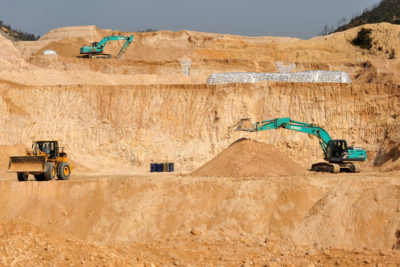We Rarely Remember the Rare Minerals
We Rarely Remember the Rare Minerals
By: Urvi Vallapareddy
Smartphones, military equipment, aircraft engines, and wind
turbines all require a resource in common: rare earth minerals (REM). REMs
include dysprosium, europium, terbium, and thulium. These elements are
necessary for developing high-tech products, therefore making REMs a
highly demanded mineral. Problematically, mining for REMs causes extensive
water and soil pollution. Even though REM mining has caused significant
destruction in mineral abundant areas, like China, technology companies need
these minerals to produce their products, so the pollution continues to
intensify. It is not just products like iPads and AirPods, wind turbines
require up to TWO TONS of rare earth magnets. It becomes challenging when
sources of clean energy require destructive mining in order to be
constructed.
 |
| workers at a rare earth mining site in Ganxian county, China |
When it comes
to mining, operations have often ruined the land. For instance, mountaintop
removal mining has caused certain land forms to be permanently reshaped. China
has been a global leader for supplying rare earth minerals, so they have a
serious pollution problem. At this point, areas near mining facilities are
plagued with concrete leaching ponds and plastic lined wastewater pools.
They are constantly facing the potential risk of contaminated contents spilling into
waterways. Essentially, mining for REMs is growing in demand, but the process
leaves habitats polluted and fragmented.
Sadly the
problem continues. As the Arctic Circle continues to melt, permafrost increases
methane emissions, which is a dangerous positive feedback loop. On the “bright
side” for large tech companies and countries, the Arctic is abundant in REMs.
These minerals become more accessible every year as the ice melts. The battle
for REMs is becoming a geopolitical issue as well as an environmental
concern.
Portions of
the Arctic are claimed by nations like Canada, Denmark, Norway, Russia, and the
US. More countries are realizing the commercial value of the area, so claims to
land in the Arctic Circle overlap. And it is not just REMs in the Arctic,
approximately 30 percent of the world’s natural gas and 16 percent of the
world’s oil is located there. Gaining access to these resources is commercially
profitable. The territorial fight may worsen as the ice melts further The
development of new technology will require REMs and corporations like Apple,
Huawei, and Tesla are dependent on access to these minerals. Like all mined
resources, REMs come in a finite amount and are destructive to extract. So do
you believe corporations should financially support REM mining operations to
help reconstruct that land? What is a solution to ease tensions over competing
claims in the Arctic Circle? How do you feel about wind turbines requiring so
many REMs?

Comments
-Andrew Thomas